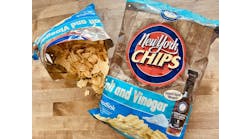Food & beverage processors have made good on pledges to cut sodium, according to a 15-year study published online by JAMA Internal Medicine, part of the Journal of the American Medical Assn.
The amount of sodium that households acquired from packaged food & beverage purchases decreased significantly – by 12 percent – between 2000 and 2014. Overall, sodium consumption decreased by 396mg per day. But more work needs to be done, as 98 percent of U.S. households still were using products with more sodium than "optimal levels" (1.1mg/kcal or less).
The study had a huge sample – 172,042 households (754,608 year-level observations) using the Nielsen Homescan Consumer Panel. While reductions were seem in all top food sources of sodium between 2000 and 2014, they were particularly significant in condiments, sauces & dips (-114mg/100g) and "salty" snacks (-142mg/100g). Decreases began in 2005 and continued through 2014.
Food & beverage processors have been in the crosshairs on this subject, as Americans get more than 75 percent of their sodium from processed foods, according to the Centers for Disease Control and Prevention. Americans currently consume 3,400mg of sodium per day, far more than 2,300mg suggested in the 2015 Dietary Guidelines for Americans (for the sizable portion of the population with hypertension, the recommend limit is 1,500mg per day).
The study was conducted by Jennifer Poti, Elizabeth Dunford and Barry Popkin, all PhDs. The full article is at jamanetwork.com/journals/jamainternalmedicine/fullarticle/2629447.

